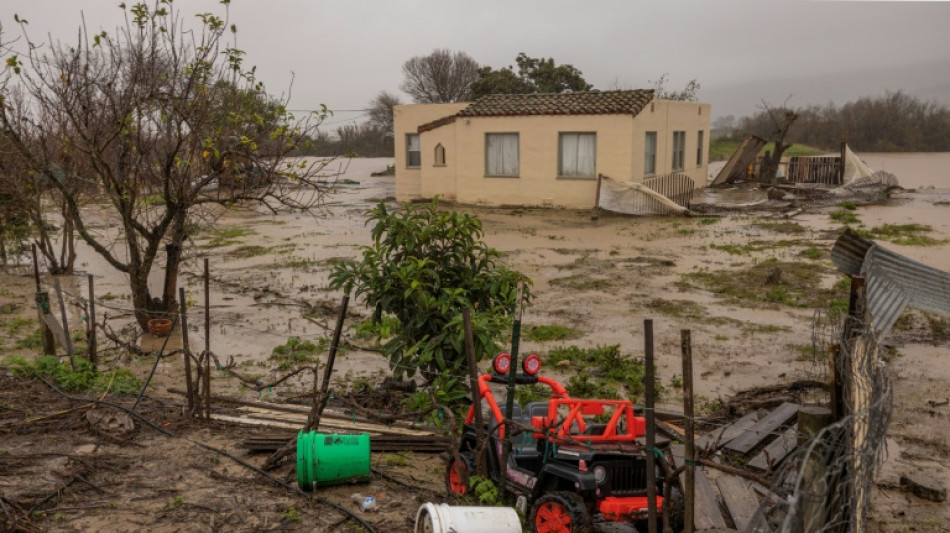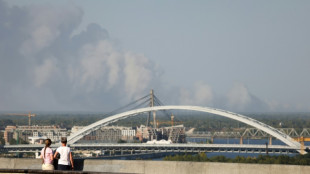

New storms hitting California as it faces already 'disastrous' floods
The latest in a damaging succession of storm systems blew into California on Saturday, bringing heavy flooding to already waterlogged regions and threatening snowfalls of up to six feet (two meters) in areas.
The latest system was expected to bring "heavy lower-elevation rain, significant mountain snow, and strong winds," with "another surge of Pacific moisture" expected Monday, the National Weather Service (NWS) said.
It predicted "disastrous flooding" across the lower Salinas River valley, an important agricultural region south of San Francisco Bay.
An AFP journalist saw the Salinas River overtopping its banks in many spots, at times covering farm fields for hundreds of yards (meters) even as rain continued under leaden skies.
The storms of recent weeks were originally welcomed -- coming after years of drought -- but by now have brought "disastrous" flooding, officials say.
Around 2030 GMT, there were 36,000 homes without power, according to poweroutage.
At least 19 people are known to have died from storm-related causes.
"This place was hit hard by the drought over the past years," 58-year-old farmworker Manuel Paris told AFP near Salinas. "We're not used to this much rain anymore."
The NWS said an additional two to three inches of rain (5.0 to 7.5 centimeters) could cause new flooding and mudslides, with parts of the Sierra Nevada seeing three to six feet of snow, and heavy winds buffeting central and coastal California at up to 50 miles per hour (80 kph).
- Impassable roads -
The most populous US state has been pummeled by near-record downpours over three weeks -- an average of nine inches of rain has fallen -- with the Salinas Valley among the hardest hit.
On Friday, forecasters warned that the Monterey Peninsula could be cut off and the whole city of Salinas -- home to 160,000 people -- could be hit by flooding.
But on Saturday an AFP journalist said the city itself had so far been largely spared.
One area resident, Kelley O’Connell, said the bursting of a levee near her home had worried her.
"If they release water from the dams or we get more rain, we’re just a field away," she told the San Francisco Chronicle as she collected sandbags.
Evacuation orders and warnings were widespread, with forecasters saying major roads could become impassable for days -- including highways linking the Monterey Peninsula with the rest of the county.
Resident John Guru said he was taking no chances, with four days' supplies at home and two days' worth in his car.
"This is crazy," he told the Monterey Herald. "I was not anticipating anything like this."
- Heavy snow -
Between storms, workers have rushed out to clear up some of the mess, shoveling mud from roads even in the heart of Los Angeles and using heavy machinery to remove fallen trees or clear rockslides.
An AFP journalist saw tractors in fields near Salinas fighting to pump floodwaters back into the river. Newly falling rain was not helping.
And forecasters say the unsettled weather in the US West -- associated with what is called an atmospheric river pattern -- is not done.
Over the mountains, heavy snow was making travel dangerous or impossible on a three-day holiday weekend that honors civil rights leader Martin Luther King Junior, when many people normally would be heading to ski resorts.
Amid heightened risk of avalanches, officials urged people to stay home.
Authorities in the Lake Tahoe resort area posted pictures showing dozens of vehicles lined up on a road, stalled by a fierce blizzard.
Among those who have died in the last three weeks were drivers found in submerged cars, people struck by falling trees, and a husband and wife killed in a rockfall.
Winter storms are not unusual in California. But global warming is making them wetter and wilder.
The latest storms are not enough to end the drought but are "making a good dent," Jay Lund, a water resources specialist at the University of California, Davis, told the Chronicle.
M.Pacheco--LGdM




